Anne Emily Brinsmead and the Latey Family
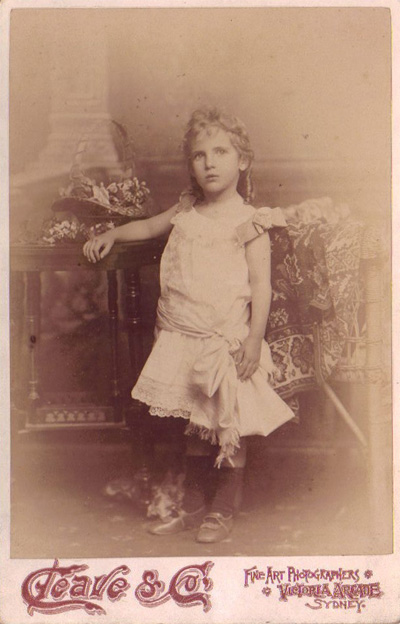 A young Annie Brinsmead taken in Sydney, Australia
A young Annie Brinsmead taken in Sydney, AustraliaAnne Emily Brinsmead was the daughter of John and Susan Brinsmead's youngest son Horace George Brinsmead. Annie was born on February 7th, 1887 at Virginia Plantation, Freshwater, in the area now known as Brinsmead, near Cairns, Queensland, Australia.
Her early life involved both Australia and England. The family moved from the Cairns area down to Sydney. We have a record of her visiting the 1894 International Exhibition in Hobart, with her parents and her brother Max. She arrived in England in about 1898, with her parentsa, when her father Horace returned to take on a greater role in managing the newly incorporated piano firm.
As a young woman of 21, she had to endure the shock of her father's 1908 suicide and the devastating effect that must have had on her mother and younger siblings Max, Cecil, Noel, Eric, Una, and Denis. In 1916, she lost a brother to the War when Cecil Horace was killed in Turkey.
The 1911 census finds Annie listed as a visitor at 30 Stanley Gardens, South Hampstead in London with Constance Latey and her two sons, Louis John and William.
On July 16th, 1912, Annie (sometimes known as Midge) married William Lash Latey, joining one of London's more interesting families, prominent because of their involvement with the Illustrated London News.
Anne Emily Latey was the oldest Brinsmead family member it was your editor's privilege to meet in person. By then in a nursing home, aged about 93, she was present for a dinner party given by her son Maurice Brinsmead and his wife Barbara. She was spry and alert and told stories of her early life in Australia, including having played the piano for the famous Nellie Melba. The next day, Wendy Brinsmead and your editor were also privileged to visit briefly with her other son, Sir John Brinsmead Latey. Annie passed away on February 5th, 1983.
William Lash Latey
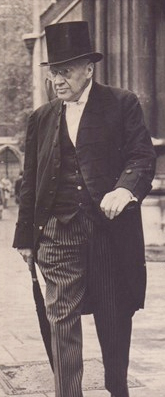 William Lash Latey
William Lash Latey William Lash Latey, like his father and grandfather before him (see below) started life as a journalist.
Annie and William's wedding to place at St. Mary the Virgin Church, Hampstead. Both fathers had by then passed away. The two mothers acted as witnesses.
 The July 16th, 1912 marriage of William Lash Latey and Anne Emily Brinsmead
The July 16th, 1912 marriage of William Lash Latey and Anne Emily Brinsmead
William Latey entered the law, being called to the bar of the Middle Temple, one of the four Inns of Court. Middle Temple has always housed barristers chambers (offices), they also contained living accommodation for some barristers. William and Annie Latey lived right in the Inns of Court at 3 Temple Gardens. Sons John and Maurice thus grew up in Temple Gardens, just North of the Thames Embankment, surrounded by all the trappings of the English legal system. At the time the 1939 Register was compiled, William and Annie Latey as well as son Maurice Brinsmead Latey were still living at 3 Temple Gardens.
As a lawyer, William Lash Latey specialized in divorce and probate matters. Indeed, in 1931 he authored what was, for many years, the leading text on the subject; Latey on Divorce. However, he also had a strong interest in international law and wrote articles on that topic extending beyond its matrimonial aspects. In 1921 he wrote a paper on The Law of the Air published by the Grotius Society of which he was a member.
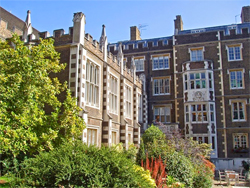 The Middle Temple - London, home to Annie and William Latey and family
The Middle Temple - London, home to Annie and William Latey and familyAnother lawyer of much the same vintage also belonged to the Middle Temple; Clifford Mortimer, the father of John Mortimer the author of Rumpole of the Bailey. John Mortimer, in his book about his father, wrote:
Getting a start in the world of divorce seemed the more difficult in that the work was shared out among a small circle of lawyers who had thus consolidated their hold on matrimonial disharmony. My father was one of the leaders of this group, another was a senior member of our chambers called 'Father William'. William Latey had two sons, one now a Judge and the other a distinguished broadcaster, who were big boys when I was a small child in the Temple. He was a small, fat, extremely clubbable man who wore pince-nez and had been, as a journalist on the Illustrated London News, posted to Russia in the days before the revolution. He would often describe to me nights when the troika was loaded with champagne and he was 'off to the gypsies'. 'Father William' was extremely kind to me and took me to dinner at the Savage Club where he would explain that it was useless to hope for a brief in your first ten years at the bar. 'We used to sit in chambers doing absolutely nothing. Then my wife would lend us balls of her wool and we would practice safe cricketing strokes with them in the corridor outside the clerk's room, sending the knitting wool for six with our rolled umbrellas.' Later 'Father William' developed this reminiscence into a speech which he would make annually at the chambers' Christmas party, and describe the first lean years at the bar when 'we had absolutely nothing to do but play with our balls'.
Rumpole fans will instantly recognize that "Father William" - Annie Brinsmead's husband - provided the inspiration for the character Uncle Tom.
William Lash Latey had a sister, Josephine and a brother Louis John. Josephine Latey married the famous British cartoonist William Heath Robinson who is the subject of a separate "Brinsmead Biography".William's brother Louis John Latey (1884-1930) also took to the law, but as a solicitor practicing from Clements Inn on the Strand in London. He was honourary solicitor to the Institute of Journalists.
Sir John Brinsmead Latey
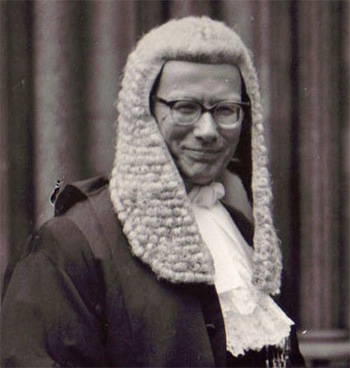 The Right Honourable Sir John Brinsmead Latey MA, MBE, PC.,
The Right Honourable Sir John Brinsmead Latey MA, MBE, PC.,Annie Brinsmead's first child, John Brinsmead Latey, was born at 4 Osborne Mansions, Chapter Road, Cricklewood, London, on March 7th, 1914, a few months before the outbreak of World War I. He was educated at Westminster School and then attended Christ Church, Oxford ( 1932-1935) where he read law. In 1936 he was called to the bar, in the Middle Temple just as his father had been, and again following his father took up practice in the area of probate and divorce.
John Latey married Betty Margaret Beresford (born 1908) in mid 1938. She was the daughter of a Psychiatrist, Dr. Edwin H. Beresford who was, at the time of Betty's birth, the Medical Superintendant of the Tooting Bec Asylum, then a new facility primarily for the care of those suffering from dementia. John and Betty Latey had two children, a daughter and a son.
When war broke out again, John Latey was originally excused from service due to his poor eyesight. However, in 1942 he joined the Pay Corps, and then transferred to the Judge Advocate's Department, becoming a Lieutenant-Colonel, and as a result of his service received an MBE.
After the war, John Latey returned to the practice of law. He was an early and vigorous proponent of conciliation in cases of divorce. He "took silk" - that is became a Queen's Counsel - in 1957. In 1965, John Latey Q.C. was made a High Court Judge, serving in the Family Division, historically called "The Probate, Divorce and Admiralty Division" of which he was to become the Senior Judge, or as he put it "Head of the Wills, Wives, and Wrecks Division". His appointment came with a Knighthood. He served in that role until he was almost 75, sitting part-time Judge even after that.
Justice Latey achieved particular notoriety in a 1984 case at the Old Bailey when he presided over a divorce and custody trial involving a family of Scientologists. Much evidence was put before him about the teachings and nature of Scientology and which led him, in his judgment, to make findings unflattering to Scientology, calling it "corrupt, sinister and dangerous". Doing so led him into much publicity, although personally he remained above the fray as Judges always refrain from comment on their judgments.
In 1995 the British Government established The Latey Commission on the Age of Majority, under Sir John's chairmanship. When the report was issued in 1997 the Government quickly adopted its recommendation to reduce the age of majority from 21 to 18.
Sir John was appointed a member of the British Privy Council in 1986, a rare distinction, even for a High Court Judge. Sir John Latey retired from the Bench on January 10th, 1989. Sir John was a skilled and enthusiastic golfer. He is said to have been a Freemason. Sir John Latey maintained a strong interest in his family's history and, together with his brother Maurice, authored an early account of the Weare Giffard Brinsmeads. He believed that someone had earlier traced the family back to the 1,100's but had no proof or copy of any such study. A lifetime smoker, he died of lung cancer at home in 1 Adderbury Park, Adderbury, Banbury, Oxfordshire on April 24th, 1999, survived by his wife and two children. There were several obituaries published including one in The Independent.
Maurice Brinsmead Latey
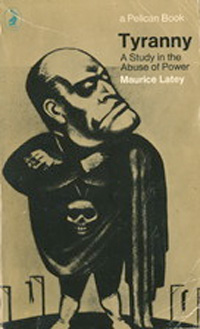 Tyranny - A Study in the Abuse of Power by Maurice Brinsmead Latey
Tyranny - A Study in the Abuse of Power by Maurice Brinsmead Latey 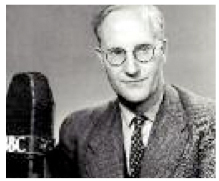 Maurice Latey broadcasting from the BBC
Maurice Latey broadcasting from the BBC Annie Brinsmead's second son, Maurice Brinsmead Latey was born on May 15th, 1915. As a boy, he attended Giggleswick School (1931-1932), a boarding school in North Yorkshire. He lived with his parents in the Middle Temple until he married in 1939 to Mary Barbara Mitchell.
Also in 1939, Maurice Latey began to work for the BBC's External Services, specializing particularly, but not exclusively, in Eastern Europe. He was working there at the time of the outbreak of World War II. The war years were extremely important for the development of what is now the BBC World Service. Its broadcasts into occupied Europe were famous. The BBC's on- line history reports:
Shortly before the outbreak of war, Hitler offered a peace deal to Britain. He got his response even before the British Government had considered it. Maurice Latey, working on the German Service, poured scorn on the offer. The next morning Latey read newspaper headlines announcing: 'BBC rejects Hitler peace offer'. He recalled: 'I approached the office in fear and trembling, only to find on my desk a note from my boss congratulating me on my effort.'
After the war, they lived at 189 Cromwell Road, London. In 1952, Maurice travelled to the USA. In 1959 he accompanied Prime Minister Harold MacMillan on his visit to the USSR.
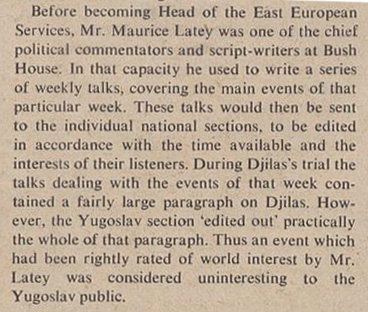 The Spectator - March 11th,1960, page 7
The Spectator - March 11th,1960, page 7The Spectator, in relation to the Djilas trial taking place in the then Yugoslavia, described Maurice Latey's role at the BBC during the 1950's when he was Editor, Talks and Features, External Broadcasting.
He became Head of the BBC's East European Service in 1959, a position he held until 1969. One might think this was the BBC's version of the American "Radio Free Europe". However, the BBC took quite a different view of its role. Latey himself had no truck with propaganda, saying in 1964:
We are speaking to people who are fed [up] to the back teeth with slogans and dogmas. They certainly do not tune into the BBC to get counter-slogans and counter-dogmas. If we tried to thrust any ideological line down their throats we should not only be misrepresenting the nature of British society - an open or plural society in which many ideologies compete; we should also alienate the most valuable part of our audience...the technical intelligentsia.
In 1973, he was in Egypt, reporting from there on the Yom Kippur War.
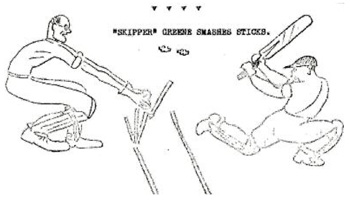 A cartoon drawn in 1941 by Maurice Brinsmead of the Bushmen. Skipper Greene is Broadcaster Hugh Greene,
sometime Director General of the BBC and brother of author Graham Greene
A cartoon drawn in 1941 by Maurice Brinsmead of the Bushmen. Skipper Greene is Broadcaster Hugh Greene,
sometime Director General of the BBC and brother of author Graham GreeneThe BBC Overseas Service operated from Bush House in London. Early in the 1940's, employees of the service, then at Bletchley (of Enigma Fame) formed a cricket team called "The BBC Bushmen", a team that is apparently still playing (it certainly was in 2012). Maurice Latey, who played on the team from its early days, in 1984, wrote a pocket history of the club "The Quest for the Bushmen" said to be "slim, but exquisitely funny". This original account has since been brought up to date by BBC Parliamentary Correspondent Peter Hill.
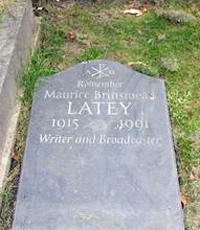 Maurice Brinsmead Latey's grave in Gunnerbury Cemetery, London
Maurice Brinsmead Latey's grave in Gunnerbury Cemetery, London
Maurice Latey received an OBE (Order of the British Empire) for his work with the BBC. Maurice Latey's papers are deposited in the Bodleian Library at Oxford University. There is an award in his name for those wishing to study "politics or international relations working on aspects of democracy, freedom, and religion".
Maurice Latey died in London on June 15th, 1991. He was survived by his wife Barbara (Mary).
The Latey Family Background
The Lateys, like the Brinsmeads, came to London from North Devon. They too settled in the St. Pancras area of London. They achieved success in journalism and in the law.
John Lash Latey
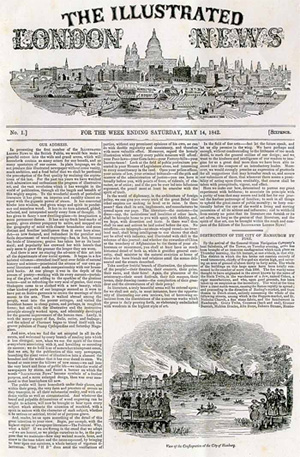 The first
edition of the Illustrated London News - May 14th, 1842 - which included a contribution from John Lash Latey
The first
edition of the Illustrated London News - May 14th, 1842 - which included a contribution from John Lash LateyJohn Lash Latey left North Devon at much the same time as John Brinsmead. It was Latey's grandson, William Lash Latey, who married John's granddaughter Annie Emily Brinsmead.
John Lash Latey was the son of Thomas Latey and Elizabeth Lash (hence the middle names). He was born in Tiverton June 14th, 1808. Initially he was thought headed for the church, following in the footsteps of his Uncle, a Canon of Bristol Cathedral. However, as an obituary described it "Mr. Latey had a literary bent of mind and a poetic gift". While still in Devon he wrote articles for the North Devon Journal. We do not know exactly when he arrived in London, but it was before 1843 since his only son, John, was born in London (Wenlock Road, Islington) in that year. The 1851 census shows him as a journalist and printer. He wrote a number of articles for Lloyd's News which began publishing in 1842. He also contributed to its rival, the Illustrated London News, starting with its very first edition on May 14th, 1842. On occasion he wrote under the name "Codlin" and at others "A Working Man", the later used for a particularly influential article describing the new Poor Law in layman's terms. He was a solid liberal and a supporter of the Reform Bill.
The family initially lived in Shoreditch, but soon moved to 29 Swinton Street in the King's Cross - St. Pancras district. By 1871 they had moved to 69 Gloucester Crescent. In 1858, John Lash Latey was appointed the editor of the Illustrated London News, a position he held for 32 years, until about a week before his death at age 82, on January 6th, 1891. He died at his home in Camden Square from pleurisy and congestion of the lungs. It is hard to exaggerate the importance of the paper during this period with its weekly accounts of news at home and activities throughout the world. It was famous, for example, for its coverage of the American Civil War.
John Latey
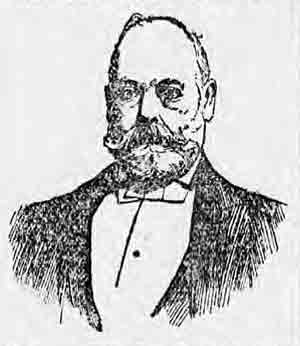 John Latey - 1842-1902
John Latey - 1842-1902John Latey, the son of John Lash, also worked as a journalist. He was born on October 30, 1842 and lived to be 60 years old, passing away, in London, in 1902. He was educated at Barnstable and at the Working Men's College in London (1860-1864). On the 1861 census, at age 18 and still living at home, he is listed as a Newspaper Publisher. He started his career with The Penny Illustrated newspaper with which he was still associated in 1900. A liberal paper, it was an affiliate to the Illustrated London News. Over his career, John held several other journalistic positions, wrote books and contributed articles. For fifteen years, writing as "The Silent Member" he was the parliamentary correspondent for the Illustrated London News. He was a founder of the London Press Club and a fellow of the Institute of Journalists.
He must have an athletic bent as he was the honourary secretary of the London Swimming Club, supervising a race in the Serpentine in Regent's Park in 1866. In 1871, he is still single and living at home, then listed as a Newspaper Editor.
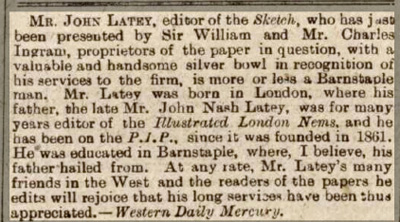 John Latey's Obituary from the North Devon News
John Latey's Obituary from the North Devon NewsHowever, one year later he married Constance Lachenal. The couple had five children, Ernest, Josephine Constance, Philip, Louis John, and William Lash. In 1901 the family was living in John Lash's old house on Camden Square. John Latey died on September 26th, 1902 apparently after a long and painful illness. At the time of his death he was the editor of The Sketch a position he assumed in 1899.
It is interesting that the West country newspapers would still claim John (the son) as "a Barnstable Man". He is buried, like John Brinsmead, in Highgate Cemetery.
